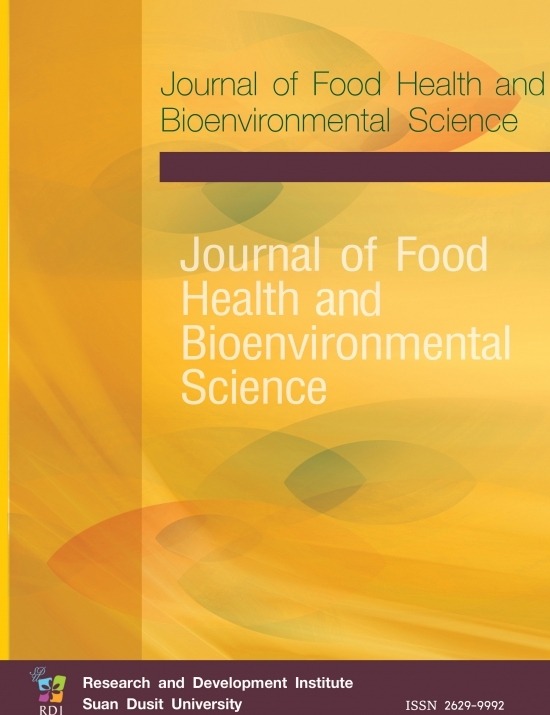Development of Sai Krok E-san Kai (Chicken Fermented Sausages) with Riceberry Rice
Keywords:
Fermented Sausages, Riceberry Rice, Consumers’ Acceptance, Sai Krok E-san KaiAbstract
This research aims to (1) study the ratios of sticky rice to Riceberry rice in Sai Krok E-san Kai with Riceberry rice, at 70:30, 50:50 and 0:100 (2) compare the nutritional value between control Sai Krok E-san Kai and Sai Krok E-san Kai with Riceberry rice and (3) carry out consumers’ acceptance test of Sai Krok E-san Kai with Riceberry rice. The study showed that the most accepted ratio of sticky rice to Riceberry rice is 50:50, with overall liking score of 7.48±1.14 (moderately like to like very much). From the comparison of nutritional value in control Sai Krok E-san Kai and Sai Krok E-san Kai with Riceberry rice, it was found that the control sample had 181.29 kcal of energy, 8.29 g fat, 13.12 g carbohydrate, 2.58 g dietary fiber, 0.45 mg iron and 0.69 mg zinc. On the other hand, Sai Krok E-san Kai with Riceberry rice had 163.65 kcal of energy, 7.49 g fat, 10.34 g carbohydrate, 4.86 g dietary fiber, 0.97 mg iron and 0.75 mg zinc. Moreover, the consumer acceptance test of Sai Krok E-san Kai with Riceberry rice showed that, out of 100 panelists, 89% accepted the product and 75% decided that they would purchase the product.
References
Akkarawinit, S. (2016). Riceberry rice. Retieved from http://brpd.ricethailand.go.th/index.php/standard-rice/92-riceberry
AOAC. (2012). Official Method of Analysi. (19th ed.). Arlington, Virginia USA: The Association of Official Analytical Chemists.
Chaisorn, N. (2009). Four Regions of Thai Food. Bangkok: Pailin Booknet. Halal Institute Prince of Songkhla University. (2014). Muslim Food and Halal Food. Retieved from http://www.halinst.psu.ac.th/th/knowledge-th/halalarticle-th/467-2015-02-12-02-42-07.html
Lattimer, J.M., & Haub, M.D. (2010). Effects of Dietary Fiber and Its Components on Metabolic Health. Nutrients, 2(12),1266-1289.
Lawless, T.H., & Heyman, H. (1998). Sensory Evaluation of Food - Principles and Practices. NY, USA: International Thomson. Thai Community Product Standard. (2003). Fermented Pork Sausage, Sai Krok E-san Mu (TCPS144/2546). Bangkok: Ministry of Industry.
Thai Industrial Standards Institute. (1995). Isaan Sausage Industrial Standards tis. 1266-2537. Bangkok: Ministry of Industry.
The Halal Standard Institute of Thailand. (2014). Halal Register. Retrieve from http://www.halal.or.th/th/main/subindex.php=sub&category=12&id=6
Vanichpun, A. (2003) Study microbial and physicochemical changes during fermentation of thai fermented chicken sausages (Master’s Thesis). Universiti Putra, Selangor, Malaysia.
Downloads
Published
How to Cite
Issue
Section
License

This work is licensed under a Creative Commons Attribution-NonCommercial-NoDerivatives 4.0 International License.








